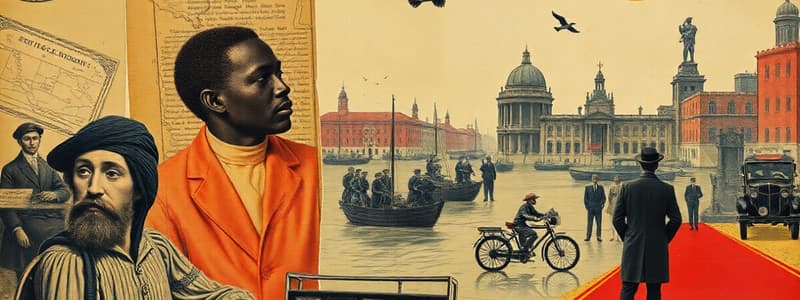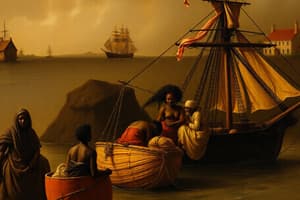Podcast
Questions and Answers
What primary factor facilitated the expansion of the transatlantic slave trade during its "golden age?"
What primary factor facilitated the expansion of the transatlantic slave trade during its "golden age?"
- Widespread social acceptance of slavery across European societies.
- Economic incentives and the pursuit of profit maximization. (correct)
- Military superiority of European powers over African kingdoms.
- Purposeful design by European monarchs seeking colonial dominance.
How did specialized slaving vessels contribute to the transatlantic slave trade's profitability during the 18th century?
How did specialized slaving vessels contribute to the transatlantic slave trade's profitability during the 18th century?
- By increasing the speed of voyages and survival chances for the enslaved. (correct)
- By intimidating rival European powers through advanced naval technology.
- By reinforcing the triangular trade route through larger cargo holds.
- By providing luxurious accommodations to attract wealthy African merchants.
What characterized the shift away from the triangular trade model during the height of the transatlantic slave trade?
What characterized the shift away from the triangular trade model during the height of the transatlantic slave trade?
- Decline in demand for enslaved labor in the Americas.
- Increased reliance on direct trade routes between Europe and the Americas.
- Preference for currency or precious metals over American goods. (correct)
- Slaves taking valuable American produce.
Which philosophical movement significantly influenced the growing opposition to the transatlantic slave trade?
Which philosophical movement significantly influenced the growing opposition to the transatlantic slave trade?
According to Enlightenment thinkers like John Locke and Jean-Jacques Rousseau, what was a fundamental natural right of all human beings?
According to Enlightenment thinkers like John Locke and Jean-Jacques Rousseau, what was a fundamental natural right of all human beings?
What was a consequence of the increased notoriety surrounding the transatlantic slave trade during the late 18th century?
What was a consequence of the increased notoriety surrounding the transatlantic slave trade during the late 18th century?
How did specialization of ships facilitate the increasing volume of the slave trade?
How did specialization of ships facilitate the increasing volume of the slave trade?
What was a main reason for the decline in triangularity of the Transatlantic Slave Trade?
What was a main reason for the decline in triangularity of the Transatlantic Slave Trade?
Which of the following describes actions taken by Britain to abolish the slave trade after 1807?
Which of the following describes actions taken by Britain to abolish the slave trade after 1807?
What was the main goal of the West African Squadron formed by the British Royal Navy?
What was the main goal of the West African Squadron formed by the British Royal Navy?
What was the significance of the Congress of Vienna in 1815 regarding the slave trade?
What was the significance of the Congress of Vienna in 1815 regarding the slave trade?
Which of the following best describes the initial reaction of other nations to Britain's anti-slave trade efforts?
Which of the following best describes the initial reaction of other nations to Britain's anti-slave trade efforts?
What was the primary reason for friction between Britain and other nations regarding the searching of ships?
What was the primary reason for friction between Britain and other nations regarding the searching of ships?
Which nation was still actively involved in the slave trade when Britain and other nations started voicing their condemnation?
Which nation was still actively involved in the slave trade when Britain and other nations started voicing their condemnation?
How did the United States' actions regarding the slave trade compare to those of Britain in the early 19th century?
How did the United States' actions regarding the slave trade compare to those of Britain in the early 19th century?
What was the state of the slave trade after the Congress of Vienna in 1815 condemned it?
What was the state of the slave trade after the Congress of Vienna in 1815 condemned it?
What was the approximate population of Sub-Saharan Africa during the transatlantic slave trade?
What was the approximate population of Sub-Saharan Africa during the transatlantic slave trade?
By 1900, approximately what percentage of the total world population resided in Sub-Saharan Africa?
By 1900, approximately what percentage of the total world population resided in Sub-Saharan Africa?
What factor is presented as the most likely cause of population stagnation in Sub-Saharan Africa during the transatlantic slave trade?
What factor is presented as the most likely cause of population stagnation in Sub-Saharan Africa during the transatlantic slave trade?
Besides gender imbalance, what other factor contributed to disturbances in population growth in West Africa during the slave trade?
Besides gender imbalance, what other factor contributed to disturbances in population growth in West Africa during the slave trade?
What is suggested as evidence that population loss caused by the slave trade was sufficient enough to cause demographic demise in Africa?
What is suggested as evidence that population loss caused by the slave trade was sufficient enough to cause demographic demise in Africa?
What cultural phenomenon is directly linked to the traditions and customs that originated among enslaved people in the cotton fields of the southern US?
What cultural phenomenon is directly linked to the traditions and customs that originated among enslaved people in the cotton fields of the southern US?
What is identified as a lasting negative consequence of the transatlantic slave trade for Afro-Americans?
What is identified as a lasting negative consequence of the transatlantic slave trade for Afro-Americans?
What is true of the transatlantic slave trade?
What is true of the transatlantic slave trade?
What year did Brazil officially ban the slave trade?
What year did Brazil officially ban the slave trade?
Approximately how many enslaved Africans were shipped to the Americas during the period discussed?
Approximately how many enslaved Africans were shipped to the Americas during the period discussed?
What was one notable activity of national navies regarding illegal enslaved trade?
What was one notable activity of national navies regarding illegal enslaved trade?
What caused the discrepancy in the number of enslaved Africans counted?
What caused the discrepancy in the number of enslaved Africans counted?
When did the slave trade essentially come to an end among major trading nations?
When did the slave trade essentially come to an end among major trading nations?
Which event is noted as a significant turning point in the fight against slavery in the Americas?
Which event is noted as a significant turning point in the fight against slavery in the Americas?
Why did illegal slave trading remain prevalent even after bans were put in place?
Why did illegal slave trading remain prevalent even after bans were put in place?
What was one of the consequences of the illegal slave trade during its operation?
What was one of the consequences of the illegal slave trade during its operation?
What was one potential economic impact of the transatlantic slave trade on Europe?
What was one potential economic impact of the transatlantic slave trade on Europe?
Which statement reflects the demographic consequences of the slave trade on West Africa?
Which statement reflects the demographic consequences of the slave trade on West Africa?
How did the slave trade affect local industrial capabilities in Africa?
How did the slave trade affect local industrial capabilities in Africa?
What was the percentage contribution of the sugar and slave industries to the total British economy?
What was the percentage contribution of the sugar and slave industries to the total British economy?
Which of the following was a significant export from Europeans to Africa during the slave trade?
Which of the following was a significant export from Europeans to Africa during the slave trade?
What role did local elites in Africa have regarding the slave trade?
What role did local elites in Africa have regarding the slave trade?
What was a significant argument regarding the economic impact of the slave trade on Africa?
What was a significant argument regarding the economic impact of the slave trade on Africa?
What type of conditions did individuals endure during the transatlantic slave trade?
What type of conditions did individuals endure during the transatlantic slave trade?
What was the primary strategic advantage abolitionists identified in targeting the slave trade over slavery itself?
What was the primary strategic advantage abolitionists identified in targeting the slave trade over slavery itself?
Which nation's ban on the slave trade had the LEAST impact on the overall movement, and why?
Which nation's ban on the slave trade had the LEAST impact on the overall movement, and why?
What broader goal did the abolitionist movement ultimately strive to achieve by initially targeting the slave trade?
What broader goal did the abolitionist movement ultimately strive to achieve by initially targeting the slave trade?
What was the key motivation for some politicians to support the ban on the slave trade?
What was the key motivation for some politicians to support the ban on the slave trade?
According to the content, what combination of factors led to the abolition of the slave trade and slavery?
According to the content, what combination of factors led to the abolition of the slave trade and slavery?
Which European nation was the first to legally ban the slave trade, and when did this law take effect?
Which European nation was the first to legally ban the slave trade, and when did this law take effect?
Why was it more difficult, according to the content, to sway public opinion against slavery on plantations compared to the slave trade?
Why was it more difficult, according to the content, to sway public opinion against slavery on plantations compared to the slave trade?
What event temporarily reversed progress in the fight against slavery, and who was responsible?
What event temporarily reversed progress in the fight against slavery, and who was responsible?
Flashcards
Transatlantic Slave Trade
Transatlantic Slave Trade
The historic trade in enslaved Africans between Europe, Africa, and the Americas.
Golden Age of the Slave Trade
Golden Age of the Slave Trade
The peak period of slave trade in the 18th century characterized by high volume and profits.
Specialized Slaving Vessels
Specialized Slaving Vessels
Ships designed for slave transport to maximize survival and profits.
Triangular Trade
Triangular Trade
Signup and view all the flashcards
Decline of the Slave Trade
Decline of the Slave Trade
Signup and view all the flashcards
Age of Enlightenment
Age of Enlightenment
Signup and view all the flashcards
Natural Rights
Natural Rights
Signup and view all the flashcards
Opposition to Slave Trade
Opposition to Slave Trade
Signup and view all the flashcards
Abolition
Abolition
Signup and view all the flashcards
Humanist ideals
Humanist ideals
Signup and view all the flashcards
Economic motivations
Economic motivations
Signup and view all the flashcards
Abolitionist Movement
Abolitionist Movement
Signup and view all the flashcards
Middle Passage
Middle Passage
Signup and view all the flashcards
Danes' ban on slave trade
Danes' ban on slave trade
Signup and view all the flashcards
French abolition in 1795
French abolition in 1795
Signup and view all the flashcards
Political influence of plantation owners
Political influence of plantation owners
Signup and view all the flashcards
Economic Impact of Slave Trade
Economic Impact of Slave Trade
Signup and view all the flashcards
Demographic Impact of Slave Trade
Demographic Impact of Slave Trade
Signup and view all the flashcards
Sugar Production and Slave Trade
Sugar Production and Slave Trade
Signup and view all the flashcards
Industrialization of Britain
Industrialization of Britain
Signup and view all the flashcards
Local Elite Involvement
Local Elite Involvement
Signup and view all the flashcards
Stifled African Industry
Stifled African Industry
Signup and view all the flashcards
Military Exports to Africa
Military Exports to Africa
Signup and view all the flashcards
Food Crop Imports
Food Crop Imports
Signup and view all the flashcards
Slave Trade Ban in Britain
Slave Trade Ban in Britain
Signup and view all the flashcards
U.S. Slave Import Law
U.S. Slave Import Law
Signup and view all the flashcards
West African Squadron
West African Squadron
Signup and view all the flashcards
Congress of Vienna
Congress of Vienna
Signup and view all the flashcards
Treaties with Portugal and Spain
Treaties with Portugal and Spain
Signup and view all the flashcards
Illicit Slave Trade
Illicit Slave Trade
Signup and view all the flashcards
Abolition Movement Internalization
Abolition Movement Internalization
Signup and view all the flashcards
Cuba's Sugar Production
Cuba's Sugar Production
Signup and view all the flashcards
Sub-Saharan Africa Population Stagnation
Sub-Saharan Africa Population Stagnation
Signup and view all the flashcards
Gender Imbalance Effect
Gender Imbalance Effect
Signup and view all the flashcards
Population Decline Causes
Population Decline Causes
Signup and view all the flashcards
Afro-American Culture Formation
Afro-American Culture Formation
Signup and view all the flashcards
Racism Legacy
Racism Legacy
Signup and view all the flashcards
Economic Disruption Impact
Economic Disruption Impact
Signup and view all the flashcards
Proof of Population Recovery
Proof of Population Recovery
Signup and view all the flashcards
Cultural Influences of Slavery
Cultural Influences of Slavery
Signup and view all the flashcards
Brazil's official slave trade ban
Brazil's official slave trade ban
Signup and view all the flashcards
Illegal slave trade
Illegal slave trade
Signup and view all the flashcards
British Navy's actions
British Navy's actions
Signup and view all the flashcards
Estimated enslaved Africans
Estimated enslaved Africans
Signup and view all the flashcards
Mortality during transport
Mortality during transport
Signup and view all the flashcards
End of slave trade
End of slave trade
Signup and view all the flashcards
Sierra Leone's role
Sierra Leone's role
Signup and view all the flashcards
U.S. Civil War's impact
U.S. Civil War's impact
Signup and view all the flashcards
Study Notes
Chapter 7: The Slow Death and Effects of the Slave Trade
-
The transatlantic slave trade's growth was driven by economic factors, not deliberate design. Its end was actively orchestrated.
-
The 18th century was a "golden age" for the slave trade, increasing volume and profits.
-
Slave ships became more specialized, improving ventilation and reducing size for faster travel. This decreased the usual triangular trade route.
-
As the 18th century continued, the slave trade faced growing opposition due to Enlightenment ideals about natural rights, notably freedom, and the rise of humanist morality.
-
Enlightenment thinkers and religious groups, particularly Quakers and Protestant Evangelicals, challenged slavery. Interpretations of religious texts shifted to view slavery as incompatible with Christian ideals.
-
Modern capitalism's emphasis on paid labor conflicted with the slave system, leading to opposition. Economic motivations for ending the slave trade included desire for a skilled workforce, a stable African market, and reducing competition.
-
Later in the 18th century, some historians argue that profits from the slave trade and sugar plantations decreased. Other researchers dispute this.
-
Industrial Revolution technologies (e.g., steam-powered sugar mills) lowered the need for some types of labor. Technological advances decreased the need for a majority of human labor, but slave labor remained profitable in some sectors.
-
Liberated slaves advocated against slavery, sharing their experiences through writings (e.g., Olaudah Equiano, Ottobah Cugoano). Revolts like in Saint Domingue also fueled the abolitionist movement.
-
The abolition of the slave trade was a gradual process, beginning with Denmark in 1792 and Britain in 1807, followed by the US.
-
The British Royal Navy's West African Squadron enforced anti-slave trade measures.
-
Despite bans, the illegal slave trade persisted.
-
Other nations gradually ended the slave trade by the 1830s.
-
The slave trade's end was not solely driven by morality but was also influenced by economics and political factors.
-
The transatlantic slave trade resulted in the forced migration of approximately 12.5 million enslaved Africans to the Americas.
Demographic and Economic Impacts
- The slave trade caused population stagnation and loss in sub-Saharan Africa.
- The loss of a significant portion of its male population is a main factor for population declines.
- The loss of labor impacted the African economy.
- The slave trade played a role in the development of new cultures and societies in the Americas. This is evident in music, cuisine, language, and other aspects of Afro-American culture.
Long-Term Effects
- Racism developed as a consequence of and justification for the slave trade, persisting in modern society.
- The slave trade had profound impacts on African and American societies.
Studying That Suits You
Use AI to generate personalized quizzes and flashcards to suit your learning preferences.




